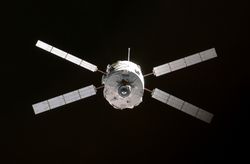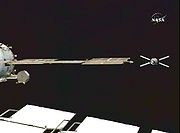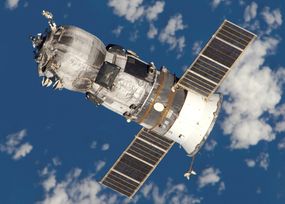Jules Verne ATV
 Jules Verne ATV approaches the International Space Station |
|
| Type | ATV |
|---|---|
| Organisation | ESA |
| Space station | ISS |
| Station crew | Expedition 16 Expedition 17 |
| Contractors | EADS Astrium (prime), Thales Alenia Space, Arianespace (LSP) |
| Carrier Rocket | Ariane 5ES |
| Launch site | Kourou ELA-3 |
| Launch date | 9 March 2008 04:03 UTC |
| Decay Date | 29 September 2008 13:31 UTC |
| COSPAR ID | 2008-008A |
| Free flight time | 2 months |
| Docked time | 5 months |
| Docking | |
| Docking port | Zvezda Aft |
| Docking date | 3 April 2008 14:45 UTC |
| Undocking date | 5 September 2008 21:29 UTC |
| Orbit | |
| Regime | LEO |
| Period | 91.34 min |
| Periapsis | 331 kilometres (179 nmi) |
| Apoapsis | 339 kilometres (183 nmi) |
| Inclination | 51.6° |
| Mass | |
| Total | 20,000 kg (44,000 lb) |
| Cargo | 2,297 kg (5,060 lb) |
| Dry cargo | 1,150 kg (2,500 lb) |
| Fuel | 856 kg (1,890 lb) |
| Gaseous cargo | 21 kg (46 lb) |
| Water | 270 kg (600 lb) |
Jules Verne ATV, or Automated Transfer Vehicle 001 (ATV-001), was an unmanned European cargo resupply spacecraft named after French science-fiction author Jules Verne.[1] The spacecraft was launched on 9 March 2008 on a mission to supply the International Space Station (ISS) with propellant, water, air, and dry cargo.
Because it is the first ATV, the spacecraft underwent three weeks of testing before it began a series of rendezvous with the ISS. It docked to the ISS on 3 April 2008 to deliver its cargo. On 25 April 2008, Jules Verne was also used to reboost the station into a higher orbit.[2] After spending just over five months docked at the station, Jules Verne undocked on 5 September 2008 and made a destructive re-entry over the Pacific Ocean on 29 September.[3]
Contents |
Assembly
The first Automated Transfer Vehicle was officially named "Jules Verne" on 9 April 2002.[4] By the end of January 2003, most of its components had been assembed.[5] These components were built in several different factories; the docking and refuelling systems were produced by RSC Energia in Russia, the pressurised section was assembled by Alenia Spazio in Turin, and the propulsion system was constructed by EADS Astrium in Bremen.[5] The propulsion system was integrated with the pressurised compartment in Bremen, before the spacecraft was moved to the European Space Research and Technology Centre in Noordwijk for testing.[5] It arrived at ESTEC on 15 July 2004.[6]
Launch and early operations
Jules Verne was launched into low Earth orbit atop the maiden flight of the Ariane 5ES carrier rocket. Lift-off from ELA-3 at the Guiana Space Centre in Kourou, French Guiana occurred at 04:03:04 UTC on 9 March 2008. The spacecraft separated from the carrier rocket 1 hour 6 minutes and 41 seconds after lift-off and navigation systems were subsequently activated. Two days later, on 11 March, the four main engines of the ATV were fired for the first time, marking the beginning of several orbital insertion boosts.[7] Overberg Test Range played a part in relaying telemetry data from a mobile station deployed in New Zealand during the launch phase.
Glitches
After in-orbit activation of the ATV's propulsion system about two hours after launch, the second of four Propulsion Drive Electronics (PDE) units, which controls a quarter of the ATV's manoeuvring thrusters, reported an unexpected difference in the mixing pressure between the fuel and the oxidiser.[8][9] Engine burns were briefly postponed whilst the fault was investigated. A restart of the entire propulsion system by the ATV Control Centre in Toulouse (France) resolved the problem. ESA reported that the mission could have gone ahead even if one quarter of the manoeuvring thrusters had been unavailable.[7]
During the free-flight phase, some shell heaters were more active than anticipated, but because the thermal and power situation remained acceptable, this did not affect the mission. Visual inspection from the space station later confirmed that some thermal blankets had partially detached.[10]
On-orbit testing and docking

Because Jules Verne was the first ATV, several demonstration tests were performed in order to confirm that it was able to safely approach and dock with the space station. After launch, the ATV spent three weeks in free flight and successfully underwent Collision Avoidance Manoeuvre (CAM) tests on 13 March and 14 March, ensuring that the CAM could be conducted as a last back-off mechanism should all other systems fail during the docking manoeuvre.[11]

Subsequently it performed two docking demonstration tests called "demo days". These tests consisted of a series of rendezvous with the International Space Station and culminated in its final test: actual docking with the aft port of the Zvezda module on 3 April 2008. The rendezvous were performed by a fully automated system using GPS and optical sensors (videometers and telegoniometers). When Jules Verne was 249 metres (817 ft) from the space station, the final docking was guided by a videometer, which fires laser pulses at cube-shaped reflectors on the Zvezda service module, and a telegoniometer, which functions like radar.[12] The ISS crew could have aborted the docking at any point up until the ATV was one metre from the station (CHOP or Crew Hands-Off Point); this was not required. Jules Verne successfully docked with the ISS on 3 April 2008 at 14:45 UTC.
29 March – Demo-Day 1

During Demo-Day 1 on 29 March 2008, the first rendezvous with the International Space Station was conducted.[13] The manoeuvre culminated in a successful rendezvous with the space station at a distance of 3.5 kilometres (2.2 mi) despite a minor anomaly with the electronic systems controlling the spacecraft's engines.[14]
Jules Verne started its approach to the ISS at 14:19 GMT. At 15:57, it reached the S2 hold point and waited there for 90 minutes to conduct tests. The ISS crew then commanded the ATV to conduct hold and retreat manoeuvres. At 17:30, the ATV was commanded to perform an escape manoeuvre, propelling it away from the station.[14]
31 March – Demo-Day 2
During Demo-Day 2, Jules Verne closed in to 12 metres (39 ft) of the International Space Station when the ISS crew simulated an abort. All targets for this Demo-Day were successfully met.[13][15]
3 April – Docking
On 3 April 2008, the ATV made contact with the Zvezda aft docking port at 14:45:32 UTC,[16] starting a sequence of docking events that included mechanical capture at 14:55 UTC and docking with the ISS a few minutes later.[17][18][13] It remained docked there for four months and later made a destructive re-entry in the atmosphere, while carrying space station waste which was stored on the ATV before departure.
Use while docked

After docking and leak checks were conducted, the ISS crew was able to enter the pressurised cargo module and access the cargo. The ATV's liquid tanks were connected to the ISS and their contents were transferred to the station. The crew can manually release air components directly into the ISS’s atmosphere. The ISS crew gradually replaced the ATV's cargo with waste for disposal.[19] In addition, 270 kilograms (600 lb) of water, 21 kilograms (46 lb) of oxygen and 856 kilograms (1,890 lb) of propellant was transferred to the Zvezda module,[17] and Jules Verne was also used to reboost the space station on four occasions. About 1,150 kilograms (2,500 lb) of dry cargo was removed from the ATV and remains aboard the ISS.[17]
Debris avoidance manoeuvre

The thrusters of Jules Verne were fired for just over 5 minutes on 27 August 2008 at 16:11 UTC to conduct a debris avoidance manoeuvre. By slowing the station approximately 1 m/s (2.2 mph) the altitude of the station was lowered approximately 1.77 km (1.10 mi).[20] This manoeuvre effectively eliminated any chance of a collision with a piece of space debris which had been part of the Kosmos 2421 satellite.
Manuscripts

Two original manuscripts by Jules Verne as well as an illustrated 19th century Hetzel French language edition of From the Earth to the Moon and Around the Moon were flown aboard the spacecraft, and have been successfully delivered to the crew of the International Space Station.[1]
Unforeseen uses
The ATV being one of the quietest places of the ISS, isolated from the rest of the station, the astronauts have used it as sleeping quarters and also as a place to perform personal hygiene activities.[21] Korean astronaut Yi So-yeon has also used it as a kind of laboratory space where she performed nanotechnology experiments.[22]
Crew aboard the ISS
The ISS crew at arrival of Jules Verne were the members of Expedition 16:
- Peggy Whitson Commander - NASA
- Yuri Malenchenko Flight Engineer 1 - Russian Federal Space Agency (RKA)
- Garrett Reisman Flight Engineer 2 - NASA
They were replaced by Expedition 17 crew in April. The crew at departure of the ATV were:
- Sergey Volkov Commander - RKA
- Oleg Kononenko Flight Engineer - RKA
- Gregory Chamitoff Flight Engineer - NASA
During the ATV attached phase, the ISS was also visited by Soyuz TMA-12 Korean spaceflight participant Yi So-yeon and by the crew of STS-124. No European Space Agency astronaut or cosmonaut was aboard the ISS while Jules Verne was docked.

Undocking and deorbiting
On 5 September 2008, Jules Verne undocked and manoeuvred to an orbital position 5 km below the ISS. It remained in that orbit until the night of 29 September.[23] At 10:00:27 GMT Jules Verne started its first de-orbit boost of 6 minutes, followed by a second boost of 15 minutes at 12:58:18 GMT. At 13:31 GMT Jules Verne had re-entered the atmosphere at an altitude of 120 km, and then successfully completed a destructive re-entry in the next 12 minutes.[24]
See also
- Automated Transfer Vehicle
- Progress spacecraft
- List of unmanned spaceflights to the ISS
References
- ↑ 1.0 1.1 "Europe's 'Jules Verne' spacecraft carries namesake's notes on maiden voyage". collectSPACE.com. 7 March 2008. http://www.collectspace.com/news/news-030708a.html. Retrieved 2008-03-09.
- ↑ "Jules Verne boosts ISS orbit". esa.int. 25 April 2008. http://www.esa.int/esaCP/SEMPEISZEFF_index_0.html. Retrieved 2008-04-26.
- ↑ "International success for Astrium: Europe’s Jules Verne mission accomplished". EADS. http://www.eads.net/1024/en/investor/News_and_Events/news_ir/2008/20090929_astrium_atv.html.
- ↑ "Jules Verne - an extraordinary space traveller". European Space Agency. 2002-04-10. http://www.esa.int/SPECIALS/ATV/ESA7NSF18ZC_0.html.
- ↑ 5.0 5.1 5.2 "2003: a challenging year to build Jules Verne". European Space Agency. 2003-01-31. http://www.esa.int/SPECIALS/ATV/SEM1LG1A6BD_0.html.
- ↑ "'Jules Verne' arrives at ESTEC". European Space Agency. 2004-07-20. http://www.esa.int/SPECIALS/ATV/SEMBU2V4QWD_0.html.
- ↑ 7.0 7.1 "Jules Verne on track for long journey to ISS". ESA. 11 March 2008. http://www.esa.int/SPECIALS/ATV/SEMJE7M5NDF_0.html. Retrieved 2008-03-11.
- ↑ Ariane 5 ES launches with ATV – suffers early fault on orbit
- ↑ Jules Verne ATV under control after a textbook launch on ESA.int
- ↑ John Ellwood, et al.: Jule Verne's journey from Earth to ISS – ESA’s first space ferry, ESA Bulletin 136, European Space Agency, November 2008.
- ↑ "Jules Verne demonstrates flawless Collision Avoidance Manoeuvre". ESA. 14 March 2008. http://www.esa.int/SPECIALS/ATV/SEMWJMM5NDF_0.html. Retrieved 2008-03-14.
- ↑ "State of the art in automatic rendezvous". ESA. 2 April 2004. http://www.esa.int/esaMI/ATV/SEMZ2O57ESD_0.html. Retrieved 2008-03-06.
- ↑ 13.0 13.1 13.2 "Flight 181: Ariane 5/ATV Mission Timeline". Spaceflight Now. 2008-03-05. http://www.spaceflightnow.com/ariane/v181/mission.html. Retrieved 2008-03-10.
- ↑ 14.0 14.1 Stephen Clark (2008-03-29). "Station resupply ship passes first demonstration day". Spaceflight Now. http://www.spaceflightnow.com/ariane/v181/080329demoday1.html. Retrieved 2008-03-30.
- ↑ ESA Updates to Jules Verne ATV Demonstration Day 2
- ↑ ESA video of capture (the exact time is shown in the upper right of the screen)
- ↑ 17.0 17.1 17.2 "ESA Portal - Europe's automated ship docks to the ISS". European Space Agency. 3 April 2008. http://www.esa.int/esaCP/SEMORO5QGEF_index_0.html. Retrieved 2008-09-20.
- ↑ Jules Verne ATV given ‘go’ for docking at www.esa.int
- ↑ Space Station crew enters Jules Verne ATV on www.esa.int
- ↑ "International Space Station Daily Report". 2008-08-28. http://www.hq.nasa.gov/osf/iss_reports/reports2008/08-28-2008.htm.
- ↑ "Jules Verne ATV reveals unexpected capabilities". ESA. 16 June 2008. http://www.esa.int/esaMI/ATV/SEM6IZUG3HF_0.html. Retrieved 2008-09-06.
- ↑ L’ATV, simple cargo spatial, dévoile des charmes insoupçonnés Jean Etienne Futura Sciences
- ↑ "'Jules Verne' begins final voyage". BBC. 2008-09-05. http://news.bbc.co.uk/1/hi/sci/tech/7598980.stm. Retrieved 2008-09-06.
- ↑ "Successful re-entry marks bright future for ATV". ESA. 2008-09-29. http://www.esa.int/esaCP/SEME556EJLF_Life_0.html. Retrieved 2008-09-29.
External links
|
||||||||||||||||
|
|||||
|
||||||||||||||||||||||||||||||||||||||

